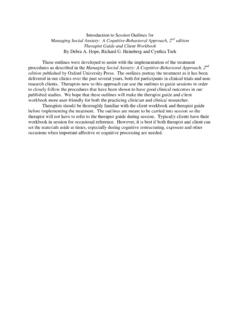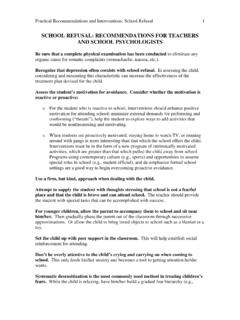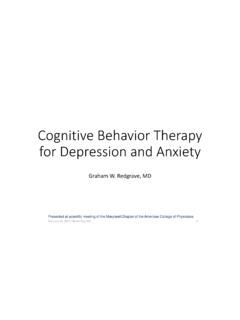Transcription of Summary Changes to DSM 4 to DSM 5
1 2015 Psych Scene Pty Ltd ABN: 82 818 675 461. All rights reserved. Summary Changes to DSM 4 to DSM 5 (American Psychiatric Publishing, DSM 5) 1. Neurodevelopmental Disorder Intellectual Disability (Intellectual Developmental Disorder) Diagnostic criteria for intellectual disability (intellectual developmental disorder) emphasize the need for an assessment of both cognitive capacity (IQ) and adaptive functioning. Severity is determined by adaptive functioning rather than IQ score. The term mental retardation was used in DSM-IV. However, intellectual disability is the term that has come into common use over the past two decades among medical, educational, and other professionals, and by the lay public and advocacy groups.
2 Autism Spectrum Disorder Autism spectrum disorder is a new DSM-5 name that reflects a scientific consensus that four previously separate disorders are actually a single condition with different levels of symptom domains. ASD now encompasses the previous DSM-IV autistic disorder (autism), Asperger s disorder, childhood disintegrative disorder, and pervasive developmental disorder not otherwise specified. ASD is characterized by 1) deficits in social communication and social interaction and 2) restricted repetitive behaviors, interests, and activities (RRBs). Because both components are required for diagnosis of ASD, social communication disorder is diagnosed if no RRBs are present.
3 ADHD Symptom threshold change has been made for adults, to reflect their substantial evidence of clinically significant ADHD impairment, with the cut off for ADHD of five symptoms, instead of six required for younger persons, both for inattention and for hyperactivity and impulsivity. Finally, ADHD was placed in the neurodevelopmental disorders chapter to reflect brain developmental correlates with ADHD 2. Schizophrenia Spectrum and Other Psychotic Disorders Schizophrenia Two Changes were made to DSM-IV Criterion A for schizophrenia. The first change is the elimination of the special attribution of bizarre delusions and Schneiderian first-rank auditory hallucinations ( , two or more voices conversing).
4 In DSM-IV, only one such symptom was needed to meet the diagnostic requirement for Criterion A, instead of two of the other listed 2015 Psych Scene Pty Ltd ABN: 82 818 675 461. All rights reserved. symptoms. Therefore, in DSM-5, two Criterion A symptoms are required for any diagnosis of schizophrenia. The DSM-IV subtypes of schizophrenia ( , paranoid, disorganized, catatonic, undifferentiated, and residual types) are eliminated due to their limited diagnostic stability, low reliability, and poor validity Schizoaffective Disorder The primary change to schizoaffective disorder is the requirement that a major mood episode be present for a majority of the disorder s total duration after Criterion A has been met.
5 It makes schizoaffective disorder a longitudinal instead of a cross-sectional diagnosis Delusional Disorder Criterion A for delusional disorder no longer has the requirement that the delusions must be nonbizarre. A specifier for bizarre type delusions provides continuity with DSM-IV. The demarcation of delusional disorder from psychotic variants of obsessive-compulsive disorder and body dysmorphic disorder is explicitly noted with a new exclusion criterion, which states that the symptoms must not be better explained by conditions such as obsessive-compulsive or body dysmorphic disorder with absent insight/delusional beliefs.
6 3. Depressive Disorders DSM-5 contains several new depressive disorders, including disruptive mood dysregulation disorder and premenstrual dysphoric disorder. To address concerns about potential over-diagnosis and overtreatment of bipolar disorder in children, a new diagnosis, disruptive mood dysregulation disorder, is included for children up to age 18 years who exhibit persistent irritability and frequent episodes of extreme behavioral dyscontrol. What was referred to as dysthymia in DSM-IV now falls under the category of persistent depressive disorder, which includes both chronic major depressive disorder and the previous dysthymic disorder 4.
7 anxiety Disorders The DSM-5 chapter on anxiety disorder no longer includes obsessive-compulsive disorder (which is included with the obsessive-compulsive and related disorders) or posttraumatic stress disorder and acute stress disorder (which is included with the trauma- and stressor-related disorders). Agoraphobia, Specific Phobia, and social anxiety Disorder ( social Phobia) 2015 Psych Scene Pty Ltd ABN: 82 818 675 461. All rights reserved. Changes in criteria for agoraphobia, specific phobia, and social anxiety disorder ( social phobia) include deletion of the requirement that individuals over age 18 years recognize that their anxiety is excessive or unreasonable.
8 This change is based on evidence that individuals with such disorders often overestimate the danger in phobic situations and that older individuals often misattribute phobic fears to aging. Instead, the anxiety must be out of proportion Panic Attack The essential features of panic attacks remain unchanged, although the complicated DSM-IV terminology for describing different types of panic attacks ( , situationally bound/cued, situationally predisposed, and unexpected/uncued) is replaced with the terms unexpected and expected panic attacks. Panic Disorder and Agoraphobia Panic disorder and agoraphobia are unlinked in DSM-5. Thus, the former DSM-IV diagnoses of panic disorder with agoraphobia, panic disorder without agoraphobia, and agoraphobia without history of panic disorder are now replaced by two diagnoses, panic disorder and agoraphobia, each with separate criteria.
9 The co-occurrence of panic disorder and agoraphobia is now coded with two diagnoses. This change recognizes that a substantial number of individuals with agoraphobia do not experience panic symptoms. social anxiety Disorder ( social Phobia) The essential features of social anxiety disorder ( social phobia) (formerly called social phobia) remain the same. However, a number of Changes have been made, including deletion of the requirement that individuals over age 18 years must recognize that their fear or anxiety is excessive or unreasonable, and duration criterion of typically lasting for 6 months or more is now required for all ages. 5.
10 Obsessive-Compulsive and Related Disorders The chapter on obsessive-compulsive and related disorders, which is new in DSM-5, reflects the increasing evidence that these disorders are related to one another in terms of a range of diagnostic validators, as well as the clinical utility of grouping these disorders in the same chapter. New disorders include hoarding disorder, excoriation (skin-picking) disorder, trichotillomania (hair-pulling disorder), substance-/medication-induced obsessive-compulsive and related disorder, and obsessive-compulsive and related disorder due to another medical condition. Body Dysmorphic Disorder For DSM-5 body dysmorphic disorder, a diagnostic criterion describing repetitive behaviours or mental acts in response to preoccupations with perceived defects 2015 Psych Scene Pty Ltd ABN: 82 818 675 461.




